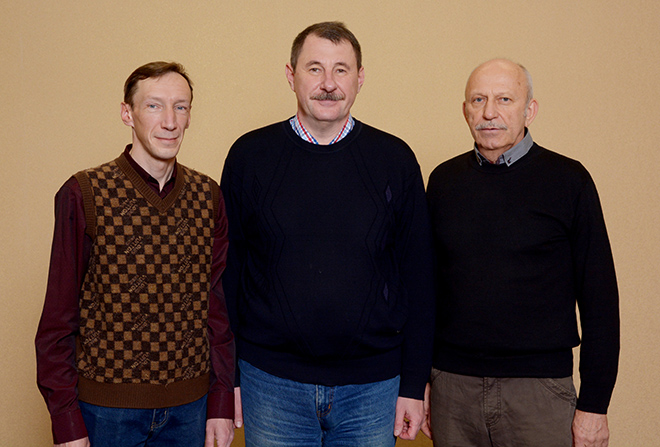
|
|---|
From left to right: M.E. Balezin, S.Yu. Sokovnin, V.G. Ilves (2017, November)
The group of electrophysical technologies originated in the laboratory of corresponding member of the RAS Yu.A. Kotov and initially participated in the development of a number of high-current electron accelerators and bremsstrahlung generators with an intermediate inductive energy storage and EEW ("VIRA-1.5", "VIRA-1.5 M"), as well as a plasma current interrupter "VIRA-2P".
Since 1996, a number of frequency nanosecond electron accelerators with a semiconductor current interrupter and a tiratron-magnetic energy compression scheme of the URT type have been developed, which work in the research organizations of Russia (IFHE RAS and UrFU) and Japan (JAERI, made in conjunction with UEMZ), as well as in the industrial technological line of radiation oxidation of polyethylene (ZAO NIIHIT-2, Saratov).
The group is working on the use of nanosecond electron beams for chemical reactions, sterilization of medical instruments and food products, water purification, production of nanopowders.
At the end of 1997, the effect of radiation-chemical sterilization of packaged products, consisting in the synergistic effect of the influence of ionizing radiation and ozone formed under the influence of an electron beam (RF Patent No. 2163144) was discovered.
In 1998 the method of antimicrobial treatment of liquids and the device for its realization on the basis of influence nanosecond high-voltage impulses (Patent of the Russian Federation No. 2316989) are developed.
In 1999, on the basis of nanoceramics created from a mixture of oxide nanopowder and micron-sized metal powder, a metal-ceramic cathode was created, which has a high resource and allows to obtain a uniform distribution of the electron beam (RF Patents No. 2158982 and No. 2191488).
In 2007, a method (RF patent No. 2353573) and a "Nanobim" plant were developed to produce nanopowders of metals and compounds based on the evaporation of a target by a pulsed electron beam in a low-pressure gas and condensation on a cryogenic crystallizer, which operate in Russia and the Republic of Korea (KAERI). In 2008 for this patent the diploma of Federal service for intellectual property, patents and trademarks in the nomination "100 best inventions of Russia" was received.
The nanobim-2 unit allows obtaining nanopowders of oxides with a high specific surface area (up to 338 m2/g) at a capacity of up to 12 g/h and specific energy consumption of ~112 kWh/g (about 5 sublimation energies). In all powders there are small-crystal and large-crystal fractions differing in the size of CRS, as well as an amorphous component. Formation amorphous components in majority of nanopowders obtained using the methods of electron evaporation by a pulsed electron beam, is a characteristic feature that makes the method of electronic evaporation very attractive to obtain and study the properties of nanopowders in interrelation with their amorphous condition.
Powders have a fractal structure, consist of aggregates ranging in size from tens to several hundred nm, formed by crystalline particles about 3-5 nm in size, with a very narrow particle size distribution. Nanopowders have a high structure defect, which affected their luminescent and magnetic properties. In particular, magnetism was found in nanopowders of aluminum, zirconium, gadolinium, silicon and zinc oxides, as well as barium and calcium fluorides.
In 2012, a device for radiation exposure of blood with a pulse power of the absorbed dose of brake radiation 42.5 kGr/s at a distance of 5 cm from the radiation source at a dose rate of 23 Gr / min. The installation received a patent of the Russian Federation № 2479329. The RNOK-300 unit can be used in blood transfusion centers, cancer institutes and relevant research centers and other institutions.
For use in a mobile installation designed for disinfection, where mass and geometric dimensions are essential, as well as the ability to transport the accelerator while maintaining efficiency, the URT-1M-300 accelerator was created.
|






